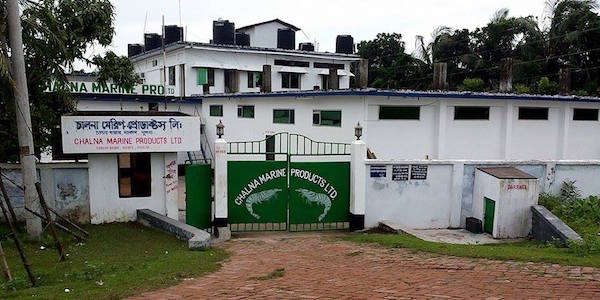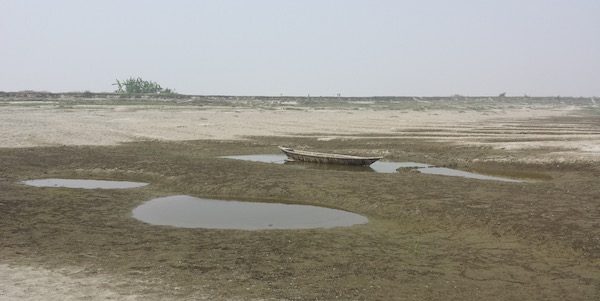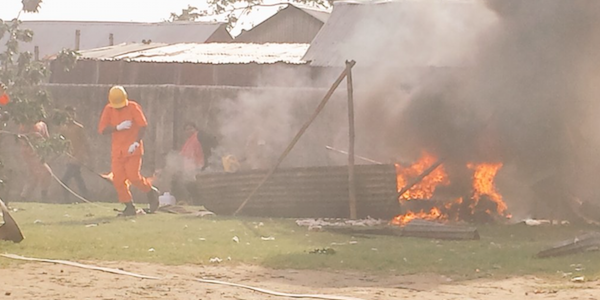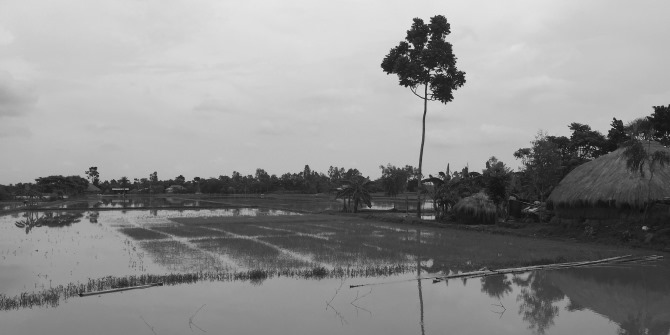Climate change has become the dominant frame for development thinking in Bangladesh, pushing aside almost every other environmental and social issue in the country. As a result, the structural causes of vulnerability are often internalised, normalised, and taken for granted. Meraz Mostafa and Pablo Bose write that rather than just “climate proofing” development efforts, the country needs to tackle contextual factors that produce vulnerability and marginalisation in the first place.
Climate change is a topic that seemingly demands all of our attention in the contemporary moment, contouring discussions of economy, ecology, politics, and society as a whole. Melting icecaps, rising sea levels, gathering storms and altered landscapes spur endless anxieties—some better founded than others. Fears of destroyed infrastructure and homes, environmental refugees on the move, economies destabilised, and political systems fractured grip public discourse and the political imaginary alike. The impact of a changing climate—an issue some have argued neither the industrialised nor the industrialising worlds seem particularly inclined to address—are being increasingly felt not in the theoretical abstract but in the multiple layers and ripples of the present.
This is especially true when one looks at one of the iconic sites of such change – the country of Bangladesh. Long a subject of intense developmentalism by the global community and laboratory for now-ubiquitous standards such as ‘participation’, ‘microcredit’, and ‘bottom-up growth’, today it is climate change that is reshaping the conversation about what Bangladesh can and should look like as it moves into its future. Its reputation as a country distancing itself from a tarnished history of poverty and underdevelopment and climbing slowly but surely into middle income status is under threat by its geographic realities: low-lying, deltaic, prone to flooding; in other words, the perfect conjunction of environmental vulnerabilities. The past decade has, as a result, seen a tremendous investment by the development establishment –international financial institutions and NGOs – as well as domestic governmental and civil society organisations in trying to address the issues through a range of (expensive) plans and schemes.
There is no doubt climate change is an enormous challenge to face. However, the problem is that it has quickly become the dominant frame for development thinking in Bangladesh, pushing aside almost every other environmental and social issue in the country. Not only have other local priorities been ignored as a result, the structural causes of vulnerability are often internalised, normalised, and taken for granted. Climate change is framed primarily as an ‘external’ threat the country needs to adapt to, as opposed to a threat resulting from a range of contextual factors that produce vulnerability and marginalisation in the first place. Often, this narrow focus on climate change reproduces exploitation and vulnerability in the country, rather than addressing it.
Climate vulnerability doesn’t just happen
Although climate change is deeply embedded in Bangladesh’s policy planning – it was one of the first countries to develop a National Adaptation Plan of Action (NAPA) as early as 2005 – adaptation is still frequently limited to small scale, technological solutions that often do not address the root cause of why Bangladeshis are vulnerable to climate change in the first place.
The southwest coastal region of Bangladesh, for instance, is not just ‘naturally’ vulnerable to climate change because it is low-lying — it was made vulnerable in part by the creation of 123 polders (small islands protected by mud embankments) from the 1960s on the suggestion of US engineers conducting a geological survey. Although the construction of the polders was meant to stabilise these islands from river erosion and protect the people living there from tidal surges, they were based on the Dutch experience of water management – and of course the Bengal delta is a very different ecosystem than the rivers of the Netherlands. The issue arises that once the embankment is breached (by a cyclone or strong tidal surge), the island is quickly flooded with seawater, which has trouble draining out, because, unlike rivers in the Netherlands, the sediment in the Bengal delta is heavy and not porous, keeping the saline water in. This affects fresh water supply, renders agricultural land infertile and even pushes residents to migrate. If that is not bad enough, it often takes months or years for the government to repair the embankments, leaving the polder waterlogged for unbearably long stretches of time.

Nevertheless, the World Bank still invested USD 400 million to improve polder embankments starting in 2014 to protect against “tidal flooding and frequent storm surges”. While these embankments are built with concrete instead of mud, they still do not address the fatal flaw that even if the embankment is breached once, the polder will be flooded. An alternative approach could be Tidal River Management (TRM), an age-old technique whereby local residents direct tidal flow to deposit sediment on flood plains, thereby improving the soil, raising the height of the flood plain over time, and maintaining the depth of the river, which decreases the chances of flooding.
While there are a few researchers and practitioners advocating for this approach, most, arguably, still see climate change as an external threat – leading them to believe the best thing to do is improve the current infrastructural system (the polders) rather than analyse how the infrastructure itself produces vulnerability.
Climate change isn’t everything
Many of the most common cited impacts of climate change are often also caused by other local environmental and development issues. Take salinity intrusion, for example. International and national media often depict salinity intrusion as a major issue – and it is. Two main explanations are given for this deeply problematic situation, one that affects the availability and quality of arable land: as sea-levels rise, more seawater will enter the Bengal delta, and salinity levels will increase; and as cyclones and tidal surges become more frequent, more seawater from the ocean will be carried in-land containing fresh water sources (the latter is likely, the former questionable).
Yet there are other fundamental causes of increased salinity levels that the Bangladesh development community hardly ever talks about – at least in public. One is industrial shrimp farming, begun in the early 1990s in the country’s southwest coastal region. Shrimp farming requires brackish (salty) water to harvest shrimp, which intrudes into nearby soils, rendering paddy farming almost impossible. Shrimp farming is thus a current threat to agriculture in the region rather than the dangers posed by the future effects of climate change. Yet ironically shrimp aquaculture – an industry that has disproportionately benefited wealthy farmers and multinational corporations – is being touted by some as a way of making the region more “resilient” against climate change.an activity that needs to be made more “resilient” against the impacts of climate change.

The other even greater factor in the salinity controversy is the diversion of freshwater from upstream by India, particularly by the Farraka and Tistra barrage. When there is less fresh water arriving from upstream, there is more seawater flowing inland from downstream, which increases salinity in the delta. It is not that climate change will not impact salinity levels, of course – but the focus on climate change should not distract the development community from having important conversations about industrial shrimp farming and/or the need to re-negotiate water sharing treaties with India (on the latter point at least, Indian officials have shown some willingness to a discuss the matter). Instead, Bangladeshi companies, such as Advanced Chemical Industries (ACI), have produced salt-tolerant seed varieties as an adaptation to climate change. Such seeds are a narrow response to salinity issues, and do not address the wider problems at stake.
Other observed environmental impacts erroneously or solely attributed to climate change include sea-level rise (particularly in context of land subsidence occurring in the coastal region), temperature rise (in that it conflates such changes with the urban heat island effect), flooding (which is almost always a man-made disaster i.e. the destruction of wetlands surrounding Dhaka which would otherwise act as a buffer), and many others as well.

Nobody is talking about land rights and exploitation
Bangladesh is a deeply hierarchal society, where patronage exists at almost every economic strata. Those who have close ties with political leaders, whether local or national, often have more protection and access to resources than those who do not (and these power relations shift depending upon the ruling party).

In many ways, this power structure is sustained by the county’s land tenureship system that has left most of the rural population landless. It is a situation that traces its history back to the British colonial era, where zamindars (local landlords) were given land tenureship in return for collecting taxes. However, they accumulated so much wealth that they were able to hire intermediaries who in turn were able to hire yet others to collect the taxes. Not only did this entrench a hierarchal class structure, but to this day those at the bottom – the ultra poor – are left penniless, landless, and shut out of political processes of power.
It is no coincidence, therefore, that some of the most vulnerable to climate change – those living in slums and char lands – are also some of the most exploited, and additionally often criminalised. Without any access to land, the ultra poor – or “most vulnerable” – are pushed to live in precarious places which are not only governed by local thugs and pirates, but are subject to eviction and river erosion.
But in neither the slums nor the chars do climate change practitioners engage seriously with land politics and issues of tenure-ship, which are perhaps amongst the most important factors in producing vulnerability and marginalization in the first place. Instead, climate change projects in slums often revolve around microcredit, waste management and disaster drills, whereas, in the char lands they revolve around farming techniques for barren land and protecting against river erosion. The worst part is, without addressing exploitative relationships, the benefits of adaptation often accrue to the local elite, leaving the truly vulnerable evermore at risk.

Climate change is still real but so are other issues
None of this means the development community should not worry about climate change, least of all because it threatens to undermine so much of the work they have already done. Yet it is important to situate climate change in an array of other social, economic and environmental systems instead of imagining it as superseding them. Bangladesh cannot simply “climate proof” business-as-usual development; rather, the country must rethink of what its goals are for development – and how to transform a society to sustain itself in rapidly changing ecological conditions, while at the same time meeting all of its citizens’ needs. A difficult task for sure.
This article gives the views of the authors, and not the position of the South Asia @ LSE blog, nor of the London School of Economics. Please read our comments policy before posting.
About the Authors
Meraz Mostafa is a research officer at the International Centre for Climate Change and Development at the Independent University, Bangladesh. He is involved in multiple projects of the centre focusing on climate finance, the Sustainable Development Goals, and climate change – related loss and damage. Meraz also manages the climate change page of the Daily Dhaka Tribune. He recently graduated from the University of Vermont with a major in geography. The views represented herein are his own.
Pablo S. Bose is an urban geographer and migration scholar who is currently Director of Global and Regional Studies at the University of Vermont. His projects focus on environment, development and displacement, urbanisation and cities of the Global South, and refugee resettlement in the Global North. His most recent books are Urban Development in India: Global Indians in the Remaking of Kolkata (Routledge, 2015) and Displacement by Development: Ethics, Rights and Responsibilities (co-authored with Jay Drydyk and Peter Penz, Cambridge University Press, 2011).







